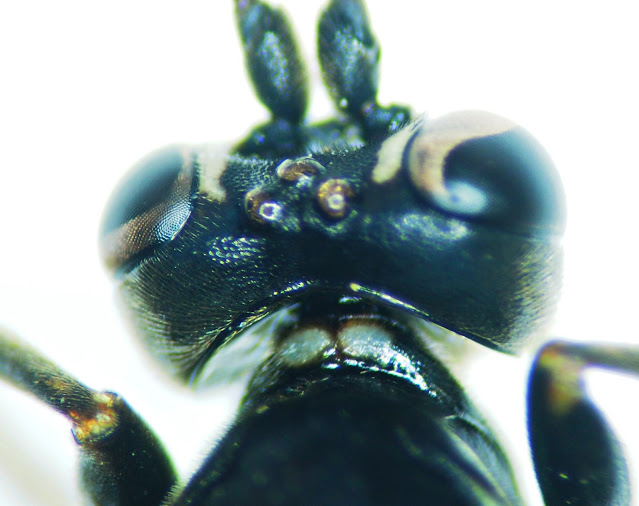I made a visit to Kirkwall's St Magnus cathedral yesterday. I've been meaning to go there for a while to see if there was any wildlife of interest. Most graveyards in Orkney are mowed and "tidied" so greatly that there is no room for wildlife. Unlike the fabulously rich kirkyards to be found further south, where wildlife is allowed to flourish, there is an unenlightened, heavy management applied to pretty much every graveyard I've visited here. In Kirkwall there are quite a number of large Sycamores in the graveyard, and surprisingly a few graves that are covered in vegetation. I mooched about a bit. There were some Ichneumonoidea that proved elusive. I did manage to photograph this leaf mine on Snowberry, which might be the dipteran Aulagromyza
cornigera (or it might be A. hendeliana, expert opinion suggests I have to rear to adult to find out).
 |
| Aulagromyza sp, at least, maybe A.cornigera. |
Apparentlly this can't be confirmed, except by rearing from the mine. There is a mine or two in the garden, I might give it a go.
Anyway, whilst in the graveyard I bumped into John Rae, or at least I found his grave. John Rae is a bit of an Orkney hero. Born in Clestrain House, we can see Clestrain Sound from our home, he was a doctor but with almost mythical survival powers out in the Canadian Arctic and sub-Arctic, for a non-Inuit anyway. John Rae learned from the Inuit, spoke their language and it is said had much respect for their way of life and their skills of living in the inhospitable (to us) land. John Rae discovered the North-West Passage. In finding the remnants of the Franklin expedition, and finding evidence that the sailors had resorted to cannibalism Rae upset the English aristocracy. Charles Dickens wrote against Rae, supporting Franklin's widow, Lady Jane, in saying that British sailors would never resort to cannibalism and that the Inuit must have been responsible for such behaviour. An age old story of class and racism. In recent times Rae has been vindicated, his truth accepted, and a plaque placed in Westminster Abbey commemorating him and (I believe) his achievements. He's worth a google.
Nearby, there's this shed.
When was this last used? What is inside? Why did someone stop using it?
Perhaps there are some bits of a John Rae boat and his snow shoes.... More likely a broken lawnmower. I'm always interested in when a person stopped using something and just left it - see Aground, on Flickr. I've begun a new photographic project, Broken, it's at an early stage, but this shed is a contender.
It has been the best year for Pintail breeding in Orkney since 2008 and a first breeding whilst I've lived here for The Shunan, the duck still has her nine chicks. She can be seen in the background of the photo below. There was a surprise arrival of Blackwits to The Shunan the other afternoon with at least 59 dropping in. This is not such good news really as I expect all of these were failed breeders from further north.
 |
| Black-tailed Godwits with Pintail and brood in the background. |
Other good news with breeding birds is that the Whooper Swans I monitor have three chicks.
 |
| Whooper Swans with their chicks. |
I have another Whooper site I should check out as well, a job for later today maybe.
At this time of year Curlews sitting on posts is a good sign.
 |
| Curlew bothered by Ephemeroptera, there were millions of them. |
 |
| Another Curlew another fence strainer to use as a lookout. |
Curlew are a rare breeding bird these days in places where they used to be common, not sure what's happening in my old stomping ground of West Yorkshire? However, their status here in Orkney is reasonably stable I believe, and there are plenty of them still.
Last post I asked for help accessing a couple of papers, I didn't really expect success as this blog has a small readership, but I should have thought more positively. Reader PM responded immediately with an email attaching the most useful of the two papers I'd requested (big thank you), next I must use the paper to try to identify to species the Alysia sp I'd been wrestling with. That effort has been delayed by my trying to tackle the ID of a large Ichneumon I found on the kitchen window a couple of weeks back. Using Broad I got it to Ichneumonini but then got stuck. However, the Ichneumon community on FB is always helpful and I enlisted help from AC who tagged GO who very kindly identified the beast as Hepiopelmus melanogaster. A quick look on NBN suggested this might be of considerable interest as the most northerly records were around Rotherham in South Yorkshire. The Broad checklist though suggests this species has occurred in Scotland. I'm currently investigating further. Bearing in mind this is a big animal at 15.4mm and a forewing of 11.5mm and it is pretty distinctive looking it might have been expected this was a more straightforward ID but GO suggested that with the Perkins key it would be a struggle to get to genus and he mentioned a couple of other similar species; not an easy one. The species is certainly new to Orkney.
When PM sent me the Alysia paper he also mentioned a source of science papers, Sci-Hub which I'd not heard of previously. This website makes scientific papers freely available (perhaps not very legally!) but shouldn't this sort of knowledge be free? The site is currently located at: https://sci-hub.hkvisa.net/ but it might not be there tomorrow I understand, a mobile site.















No comments:
Post a Comment